1999 LINCOLN TOWN CAR check engine
[x] Cancel search: check enginePage 152 of 208
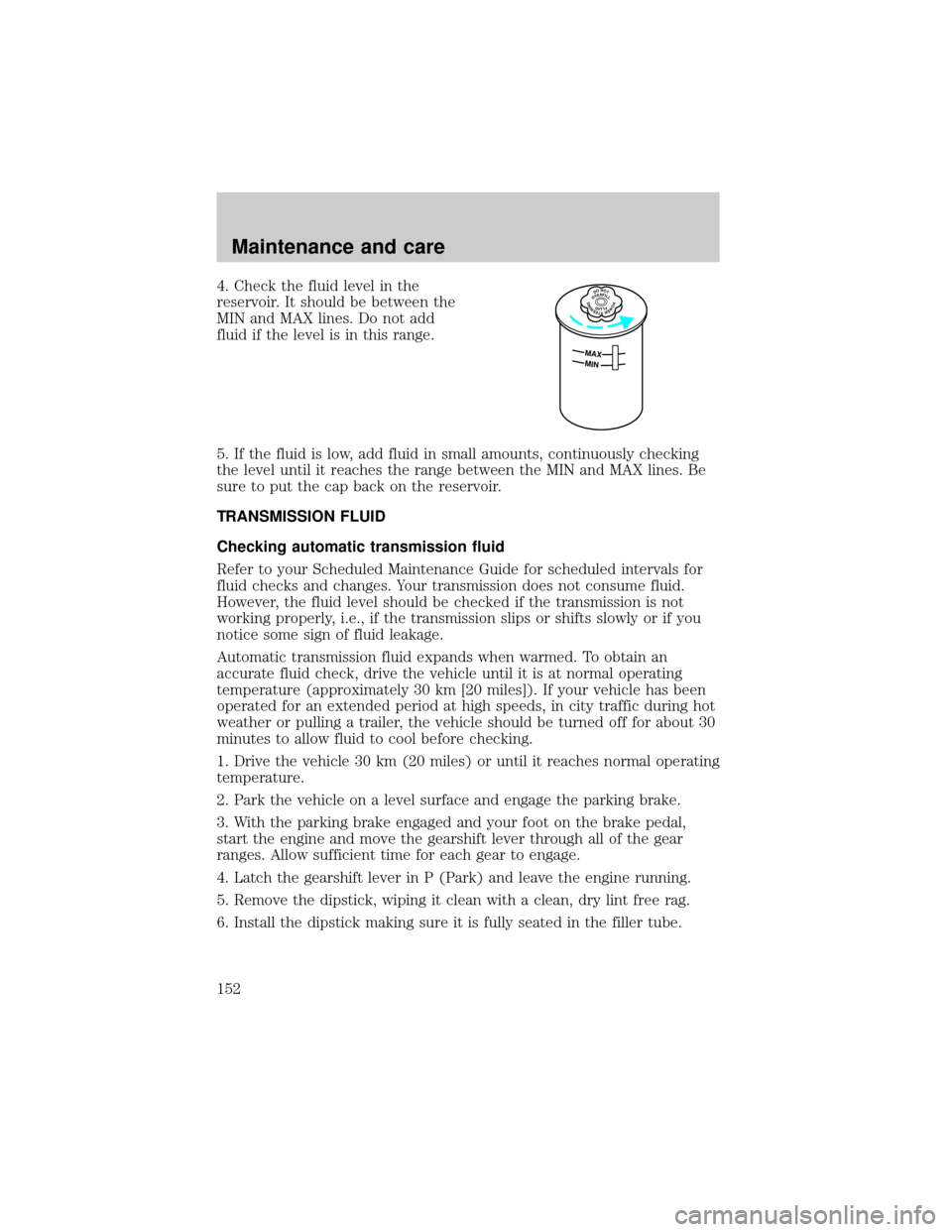
4. Check the fluid level in the
reservoir. It should be between the
MIN and MAX lines. Do not add
fluid if the level is in this range.
5. If the fluid is low, add fluid in small amounts, continuously checking
the level until it reaches the range between the MIN and MAX lines. Be
sure to put the cap back on the reservoir.
TRANSMISSION FLUID
Checking automatic transmission fluid
Refer to your Scheduled Maintenance Guide for scheduled intervals for
fluid checks and changes. Your transmission does not consume fluid.
However, the fluid level should be checked if the transmission is not
working properly, i.e., if the transmission slips or shifts slowly or if you
notice some sign of fluid leakage.
Automatic transmission fluid expands when warmed. To obtain an
accurate fluid check, drive the vehicle until it is at normal operating
temperature (approximately 30 km [20 miles]). If your vehicle has been
operated for an extended period at high speeds, in city traffic during hot
weather or pulling a trailer, the vehicle should be turned off for about 30
minutes to allow fluid to cool before checking.
1. Drive the vehicle 30 km (20 miles) or until it reaches normal operating
temperature.
2. Park the vehicle on a level surface and engage the parking brake.
3. With the parking brake engaged and your foot on the brake pedal,
start the engine and move the gearshift lever through all of the gear
ranges. Allow sufficient time for each gear to engage.
4. Latch the gearshift lever in P (Park) and leave the engine running.
5. Remove the dipstick, wiping it clean with a clean, dry lint free rag.
6. Install the dipstick making sure it is fully seated in the filler tube.DONOTOVERFILLPOWERSTEERINGFLUID
MAX
MIN
Maintenance and care
152
Page 156 of 208
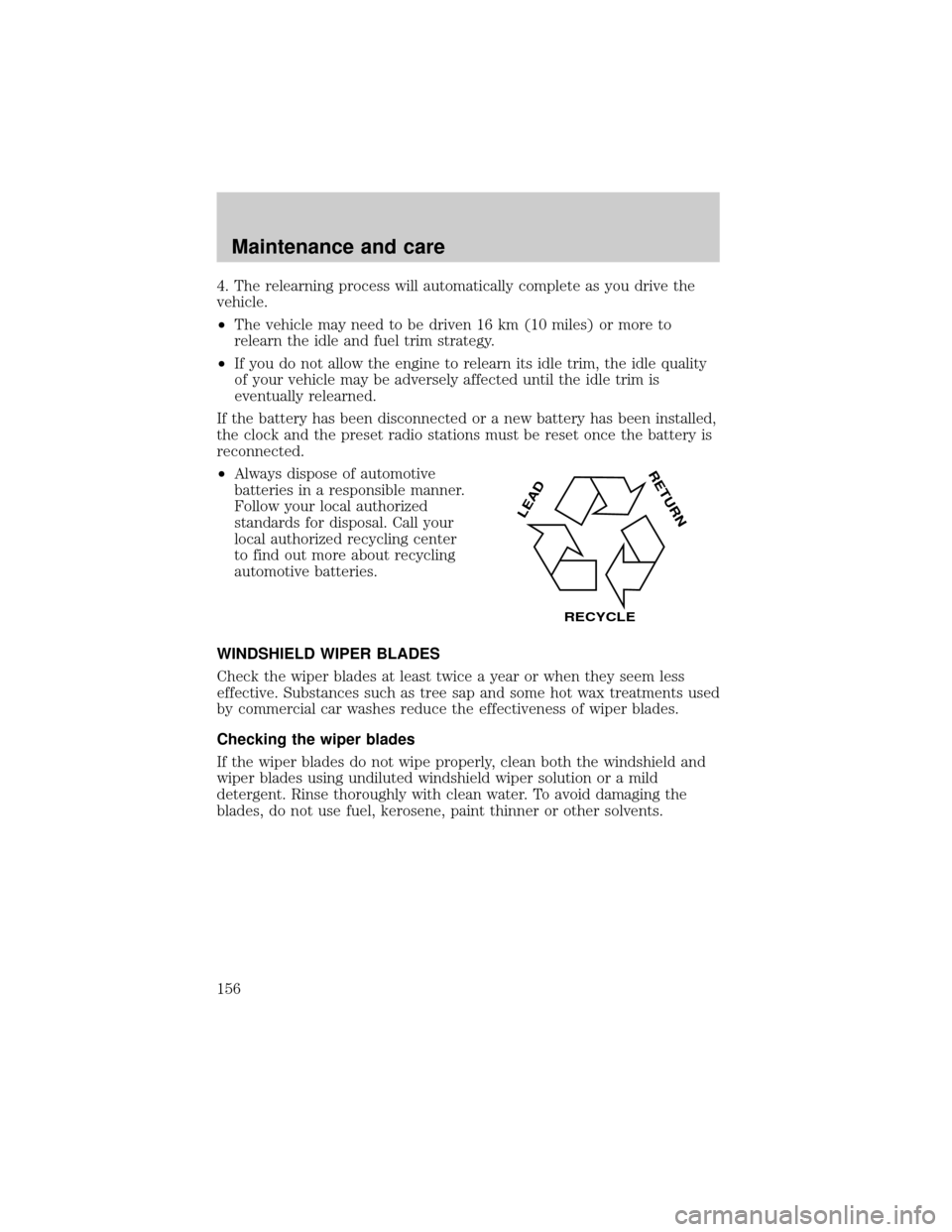
4. The relearning process will automatically complete as you drive the
vehicle.
²The vehicle may need to be driven 16 km (10 miles) or more to
relearn the idle and fuel trim strategy.
²If you do not allow the engine to relearn its idle trim, the idle quality
of your vehicle may be adversely affected until the idle trim is
eventually relearned.
If the battery has been disconnected or a new battery has been installed,
the clock and the preset radio stations must be reset once the battery is
reconnected.
²Always dispose of automotive
batteries in a responsible manner.
Follow your local authorized
standards for disposal. Call your
local authorized recycling center
to find out more about recycling
automotive batteries.
WINDSHIELD WIPER BLADES
Check the wiper blades at least twice a year or when they seem less
effective. Substances such as tree sap and some hot wax treatments used
by commercial car washes reduce the effectiveness of wiper blades.
Checking the wiper blades
If the wiper blades do not wipe properly, clean both the windshield and
wiper blades using undiluted windshield wiper solution or a mild
detergent. Rinse thoroughly with clean water. To avoid damaging the
blades, do not use fuel, kerosene, paint thinner or other solvents.
LEAD
RETURN
RECYCLE
Maintenance and care
156
Page 163 of 208
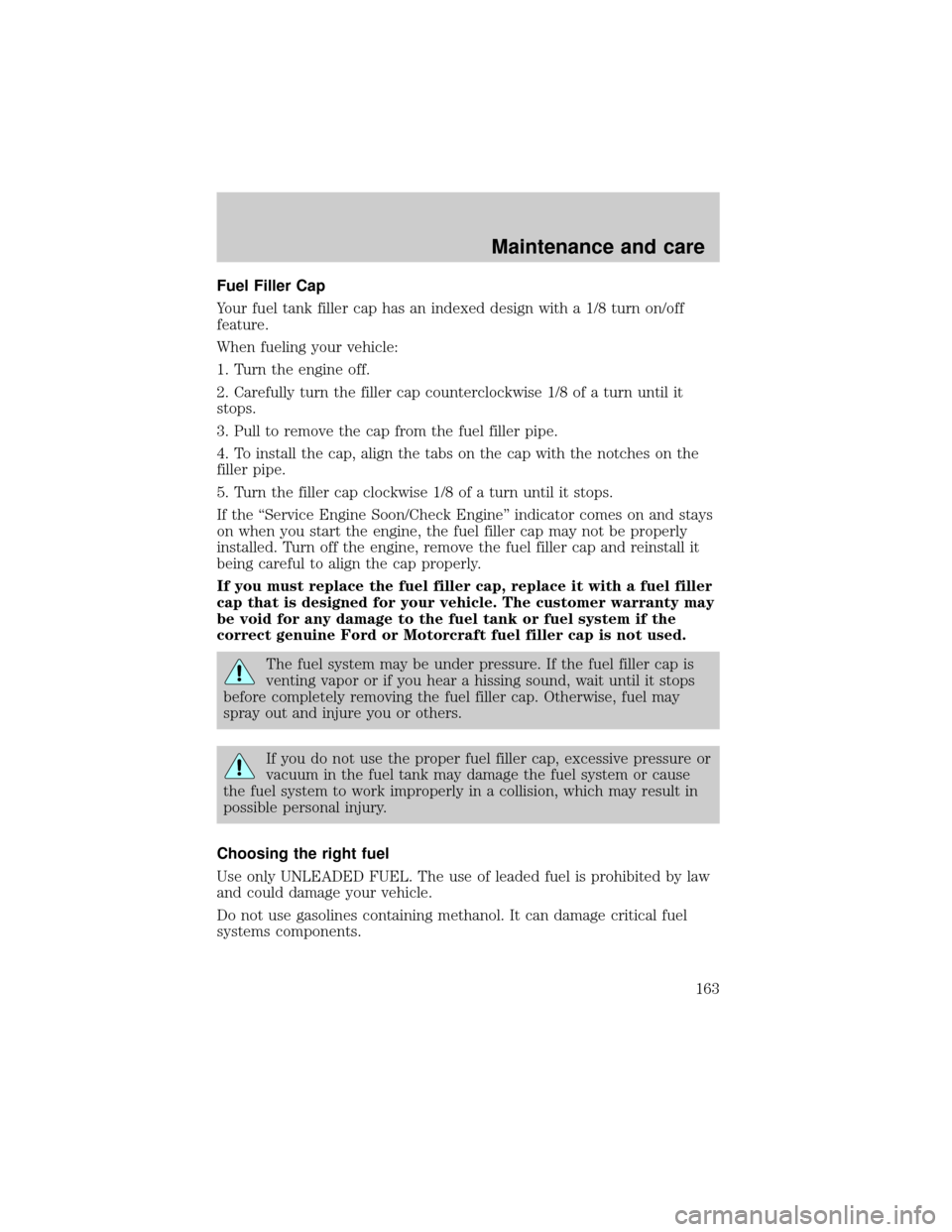
Fuel Filler Cap
Your fuel tank filler cap has an indexed design with a 1/8 turn on/off
feature.
When fueling your vehicle:
1. Turn the engine off.
2. Carefully turn the filler cap counterclockwise 1/8 of a turn until it
stops.
3. Pull to remove the cap from the fuel filler pipe.
4. To install the cap, align the tabs on the cap with the notches on the
filler pipe.
5. Turn the filler cap clockwise 1/8 of a turn until it stops.
If the ªService Engine Soon/Check Engineº indicator comes on and stays
on when you start the engine, the fuel filler cap may not be properly
installed. Turn off the engine, remove the fuel filler cap and reinstall it
being careful to align the cap properly.
If you must replace the fuel filler cap, replace it with a fuel filler
cap that is designed for your vehicle. The customer warranty may
be void for any damage to the fuel tank or fuel system if the
correct genuine Ford or Motorcraft fuel filler cap is not used.
The fuel system may be under pressure. If the fuel filler cap is
venting vapor or if you hear a hissing sound, wait until it stops
before completely removing the fuel filler cap. Otherwise, fuel may
spray out and injure you or others.
If you do not use the proper fuel filler cap, excessive pressure or
vacuum in the fuel tank may damage the fuel system or cause
the fuel system to work improperly in a collision, which may result in
possible personal injury.
Choosing the right fuel
Use only UNLEADED FUEL. The use of leaded fuel is prohibited by law
and could damage your vehicle.
Do not use gasolines containing methanol. It can damage critical fuel
systems components.
Maintenance and care
163
Page 168 of 208
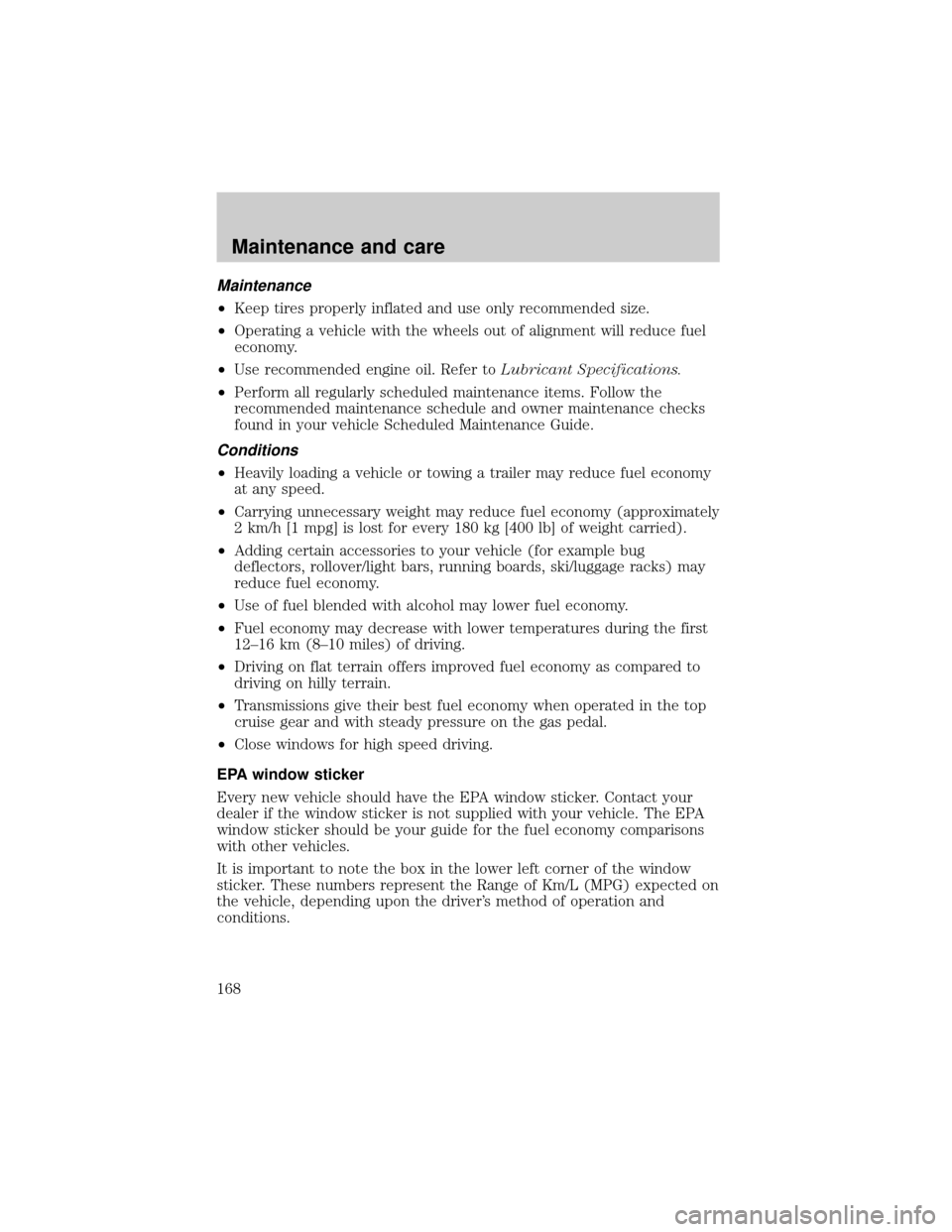
Maintenance
²Keep tires properly inflated and use only recommended size.
²Operating a vehicle with the wheels out of alignment will reduce fuel
economy.
²Use recommended engine oil. Refer toLubricant Specifications.
²Perform all regularly scheduled maintenance items. Follow the
recommended maintenance schedule and owner maintenance checks
found in your vehicle Scheduled Maintenance Guide.
Conditions
²Heavily loading a vehicle or towing a trailer may reduce fuel economy
at any speed.
²Carrying unnecessary weight may reduce fuel economy (approximately
2 km/h [1 mpg] is lost for every 180 kg [400 lb] of weight carried).
²Adding certain accessories to your vehicle (for example bug
deflectors, rollover/light bars, running boards, ski/luggage racks) may
reduce fuel economy.
²Use of fuel blended with alcohol may lower fuel economy.
²Fuel economy may decrease with lower temperatures during the first
12±16 km (8±10 miles) of driving.
²Driving on flat terrain offers improved fuel economy as compared to
driving on hilly terrain.
²Transmissions give their best fuel economy when operated in the top
cruise gear and with steady pressure on the gas pedal.
²Close windows for high speed driving.
EPA window sticker
Every new vehicle should have the EPA window sticker. Contact your
dealer if the window sticker is not supplied with your vehicle. The EPA
window sticker should be your guide for the fuel economy comparisons
with other vehicles.
It is important to note the box in the lower left corner of the window
sticker. These numbers represent the Range of Km/L (MPG) expected on
the vehicle, depending upon the driver's method of operation and
conditions.
Maintenance and care
168
Page 170 of 208

engine. This decal identifies engine displacement and gives some tune up
specifications.
Please consult your ªWarranty Guideº for complete emission warranty
information.
Readiness for Inspection/Maintenance (I/M) testing
In some localities, it may be a legal requirement to pass an I/M test of
the on-board diagnostics system. If your ªCheck Engine/Service Engine
Soonº light is on, refer to the description in theWarning Lights and
Chimessection of theInstrumentationchapter. Your vehicle may not
pass the I/M test with the ªCheck Engine/Service Engine Soonº light on.
If the vehicle's powertrain system or its battery has just been serviced,
the on-board diagnostics system is reset to a ªnot ready for I/M testº
condition. To ready the on-board diagnostics system for I/M testing, a
minimum of 30 minutes of city and highway driving is necessary as
described below:
²First, at least 10 minutes of driving on an expressway or highway.
²Next, at least 20 minutes driving in stop-and-go, city-type traffic with
at least four idle periods.
Allow the vehicle to sit for at least eight hours without starting the
engine. Then, start the engine and complete the above driving cycle. The
engine must warm up to its normal operating temperature. Once started,
do not turn off the engine until the above driving cycle is complete.
EXTERIOR BULBS
Replacing exterior bulbs
Check the operation of the following lamps frequently:
²Headlamps
²Tail lamps
²Brakelamps
²High-mount brakelamp
²Turn signals
²Backup lamps
²License plate lamp
Maintenance and care
170
Page 198 of 208
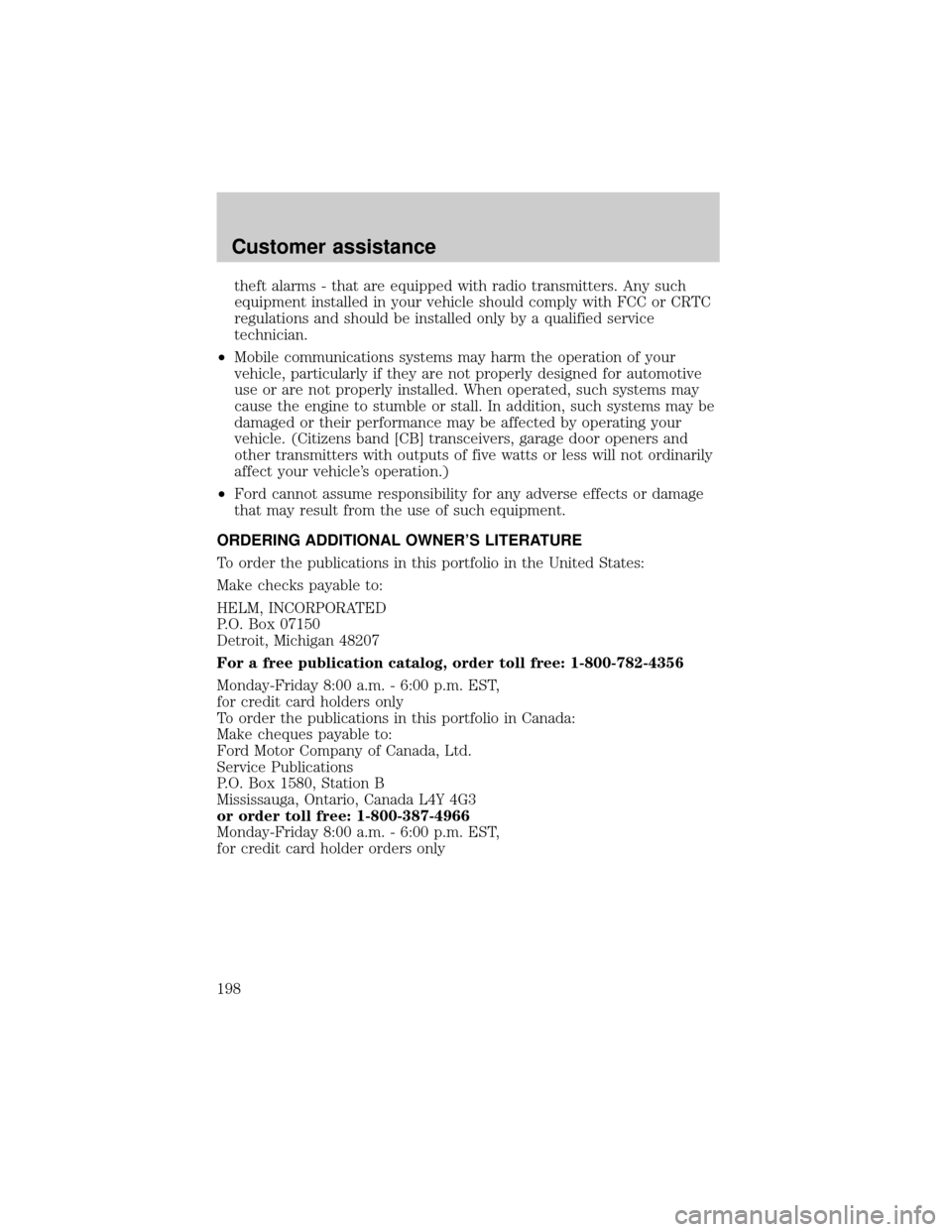
theft alarms - that are equipped with radio transmitters. Any such
equipment installed in your vehicle should comply with FCC or CRTC
regulations and should be installed only by a qualified service
technician.
²Mobile communications systems may harm the operation of your
vehicle, particularly if they are not properly designed for automotive
use or are not properly installed. When operated, such systems may
cause the engine to stumble or stall. In addition, such systems may be
damaged or their performance may be affected by operating your
vehicle. (Citizens band [CB] transceivers, garage door openers and
other transmitters with outputs of five watts or less will not ordinarily
affect your vehicle's operation.)
²Ford cannot assume responsibility for any adverse effects or damage
that may result from the use of such equipment.
ORDERING ADDITIONAL OWNER'S LITERATURE
To order the publications in this portfolio in the United States:
Make checks payable to:
HELM, INCORPORATED
P.O. Box 07150
Detroit, Michigan 48207
For a free publication catalog, order toll free: 1-800-782-4356
Monday-Friday 8:00 a.m. - 6:00 p.m. EST,
for credit card holders only
To order the publications in this portfolio in Canada:
Make cheques payable to:
Ford Motor Company of Canada, Ltd.
Service Publications
P.O. Box 1580, Station B
Mississauga, Ontario, Canada L4Y 4G3
or order toll free: 1-800-387-4966
Monday-Friday 8:00 a.m. - 6:00 p.m. EST,
for credit card holder orders only
Customer assistance
198
Page 200 of 208

Accessory delay ..........................67
Air bag supplemental
restraint system .....................91,95
and child safety seats ..............92
description ...........................91,95
disposal ......................................98
driver air bag .......................93,96
indicator light ...................7,94,97
operation ..............................93,96
passenger air bag ................93,96
Air cleaner filter .......................181
Air conditioning ..........................22
automatic temperature
control system ..........................22
Air suspension ...........................113
air leveling disabled warning,
message center .......................113
air ride switch off warning,
message center .......................113
check air ride system
warning, message center .......113
check air suspension warning,
message center .......................113
description ..............................113
warning light ...........................113
Anti-theft system ..............77,78,79
Automatic transmission
driving an automatic
overdrive .................................115
fluid, refill capacities ..............181
fluid, specification ..................184
Axle
lubricant specifications ..........184
refill capacities ........................181
traction lok ..............................117
Battery .......................................154
acid, treating emergencies .....154
jumping a disabled battery ....135
maintenance-free ....................154
replacement, specifications ...181
servicing ..................................154
Brakes ........................................109anti-lock ............................109,110
anti-lock brake system
(ABS) warning light ............8,110
brake warning light ....................8
fluid, checking and adding ....146
fluid, refill capacities ..............181
fluid, specifications ..........182,184
lubricant specifications ...182,184
shift interlock ..........................114
Break-in period .............................2
Capacities for refilling fluids ....181
CD changer .................................48
Child safety restraints ................98
child safety belts ......................98
child safety seats ......................99
Child safety seats ........................99
attaching with tether straps ..103
built-in child seat .....................99
in front seat ............................101
in rear seat ..............................101
tether anchorage hardware ...104
Cleaning your vehicle ...............176
engine compartment ..............178
exterior .............................177,180
exterior lamps .........................179
instrument panel ....................179
interior ..............................179,180
mirrors .....................................180
plastic parts ............................178
safety belts ..............................180
washing ....................................176
waxing .....................................177
wheels ......................................177
windows ..................................180
wiper blades ............................179
Clock ............................................52
Compass, electronic
calibration .................................17
set zone adjustment .................16
Controls ........................60,61,62,63
power seat ............................80,82
steering column ........................59
Index
200
Page 201 of 208

Coolant ...............................147,149
checking and adding ..............148
refill capacities .................149,181
specifications ...................182,184
Customer Assistance ................187
Ford accessories for your
vehicle .....................................194
Ford Extended
Service Plan ............................188
Getting assistance outside
the U.S. and Canada ..............193
Getting roadside assistance ...187
Getting the service
you need .................................189
Ordering additional
owner's literature ...................198
The Dispute Settlement
Board .......................................190
Defrost
rear window ..............................52
Dipstick
engine oil .................................144
Doors
door ajar warning .....................10
Driving under special
conditions
through water .........................122
Emergencies, roadside
jump-starting ..........................135
Emission control system ..........169
Engine ........................................184
check engine/
service engine soon light ...........6
coolant .....................................147
idle speed control ...................154
lubrication
specifications ...................182,184
refill capacities ........................181
service points ..........................143
starting after a collision .........123
Engine block heater .................107
Engine oil ..................................144checking and adding .......144,145
dipstick ....................................144
filter, specifications .........145,181
recommendations ...................145
refill capacities .................144,181
specifications .....144,145,182,184
Exhaust fumes ..........................108
Fail safe cooling ........................150
Floor mats ...................................69
Fluid capacities .........................181
Fuel ............................................161
calculating fuel economy .......165
cap ...........................................163
capacity ...................................181
choosing the right fuel ...........163
comparisons with EPA fuel
economy estimates .................168
detergent in fuel .....................165
filling your vehicle
with fuel ....................161,163,166
filter, specifications .........165,181
fuel filler door override ............66
fuel filler door release ..............65
fuel pump shut-off switch .....123
gauge .........................................13
improving fuel economy ........165
octane rating ....................164,184
quality ......................................164
running out of fuel .................165
safety information relating
to automotive fuels ................161
Fuses ...................................124,125
Gas cap (see Fuel cap) ............163
Gas mileage (see Fuel
economy) ...................................165
Gauges .........................................12
engine coolant
temperature gauge ...................14
fuel gauge ..................................13
odometer ...................................13
speedometer .............................13
Index
201